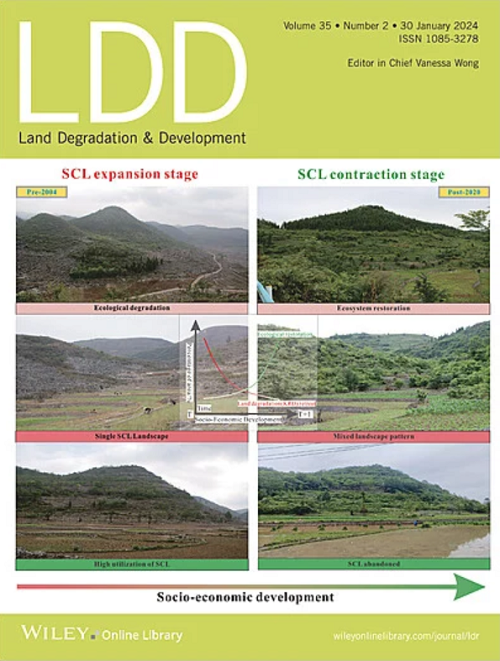Unveiling the Spatiotemporal Evolution and Driving Mechanisms of Ecosystem Carbon Sink in Rapidly Urbanizing Areas: A Case Study of the Yangtze River Delta Region
IF 3.6
2区 农林科学
Q2 ENVIRONMENTAL SCIENCES
引用次数: 0
Abstract
Ecosystem carbon sinks are vital for mitigating global climate change. In the past two decades, the Yangtze River Delta (YRD) region has undergone rapid urbanization, with its carbon sink function undergoing significant changes. Understanding the spatial evolution patterns and formation mechanisms of ecosystem carbon sinks is critically important. Existing studies often examine single factors, lacking a comprehensive assessment of how natural and socioeconomic drivers interact through multiple pathways to influence carbon sink dynamics in rapidly urbanizing regions. This study quantifies the ecosystem carbon sink in the YRD from 2000 to 2020 using the Carnegie–Ames–Stanford Approach (CASA) and a soil respiration model, and examines its spatiotemporal evolution and driving mechanisms using Global Moran's I, hotspot analysis, Mann–Kendall trend analysis, and structural equation modeling (SEM). The results reveal three key findings: (1) The total carbon sink increased from 69.91 million tons (Mt) to 103.75 Mt, with high-value areas concentrated in mountainous regions characterized by favorable climatic conditions and dense vegetation, and low-value areas located in the east, primarily due to reduced ecological resource area and fragmented ecological structures from built-up land expansion; (2) Carbon sink functions improved across 68.45% of the region, particularly where vegetation matured, but declined in 15.67% of the region, mainly concentrated in regions of urban expansion; (3) SEM indicates that the normalized difference vegetation index (NDVI) and forest land proportion (PF) enhance carbon sink functions, while the proportion of built-up land (PBL), driven by population and economic growth, is the primary negative factor. This study underscores the importance of preserving ecosystem integrity and managing urban expansion to sustain carbon sink functions, offering scientific insights into balancing ecological conservation and development in urbanizing regions worldwide.快速城市化地区生态系统碳汇时空演化及驱动机制——以长三角地区为例
生态系统碳汇对减缓全球气候变化至关重要。近20年来,长三角地区经历了快速的城市化进程,其碳汇功能发生了显著变化。了解生态系统碳汇的空间演化规律和形成机制至关重要。现有研究往往考察单一因素,缺乏对自然和社会经济驱动因素如何通过多种途径相互作用影响快速城市化地区碳汇动态的全面评估。本文采用卡耐基-阿姆斯-斯坦福方法(CASA)和土壤呼吸模型对2000 - 2020年长三角生态系统碳汇进行了量化,并利用全球Moran’s I、热点分析、Mann-Kendall趋势分析和结构方程模型(SEM)分析了长三角生态系统碳汇的时空演变及其驱动机制。结果表明:(1)碳汇总量从6991万吨增加到10375万吨,高值区主要集中在气候条件有利、植被茂密的山区,低值区主要分布在东部,主要是由于建设用地扩张导致生态资源面积减少和生态结构破碎;(2) 68.45%的区域碳汇功能有所改善,以植被成熟区最为显著;15.67%的区域碳汇功能下降,主要集中在城市扩张区;(3) SEM表明,归一化植被指数(NDVI)和林地比例(PF)增强了碳汇功能,而受人口和经济增长驱动的建设用地比例(PBL)是碳汇功能的主要负向因子。本研究强调了保护生态系统完整性和管理城市扩张对维持碳汇功能的重要性,为全球城市化地区平衡生态保护与发展提供了科学见解。
本文章由计算机程序翻译,如有差异,请以英文原文为准。
求助全文
约1分钟内获得全文
求助全文
来源期刊

Land Degradation & Development
农林科学-环境科学
CiteScore
7.70
自引率
8.50%
发文量
379
审稿时长
5.5 months
期刊介绍:
Land Degradation & Development is an international journal which seeks to promote rational study of the recognition, monitoring, control and rehabilitation of degradation in terrestrial environments. The journal focuses on:
- what land degradation is;
- what causes land degradation;
- the impacts of land degradation
- the scale of land degradation;
- the history, current status or future trends of land degradation;
- avoidance, mitigation and control of land degradation;
- remedial actions to rehabilitate or restore degraded land;
- sustainable land management.
 求助内容:
求助内容: 应助结果提醒方式:
应助结果提醒方式:


